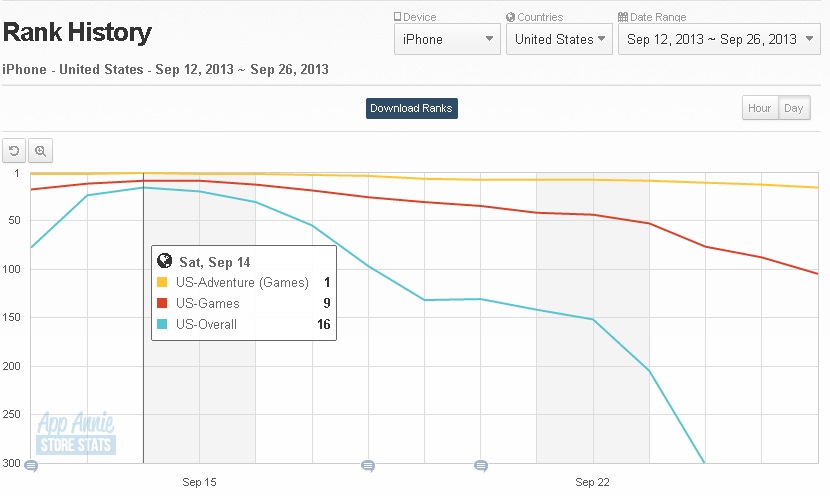The Case of Chipotle’s Scarecrow

This is the second article in a series of three commissioned by the General Director of PETS International, the trade journal for the $100 billion international pet industry. Here, I delve into the use of video games for advertising purposes, or ‘advergames.’ Advergames can be used with various levels of intensity to promote products, organizations, and viewpoints. Using the case of Chipotle’s Scarecrow, I outline the value, use, and some success metrics for games as a marketing tool.
Chipotle’s Scarecrow Campaign
In September 2013, restaurant chain Chipotle Mexican Grill set out to promote its new corporate initiative Food With Integrity. The FWI initiative was meant to draw attention to Chipotle’s emphasis on sourcing sustainably (i.e. local and organic) raised food. The low-cost restaurant chain known for its burrito’s and taco’s went against the grain for promoting its corporate ethos to the outside world. Instead of opting for a traditional marketing campaign, Chipotle contracted digital production agency Moonbot for the development of a mobile video game accompanied by an animated digital short film, both titled “The Scarecrow.”
Chipotle’s Scarecrow was released on September 12, 2013 for Apple’s iOS platform (iPhone & iPad). After five days, the adventure game had already accumulated 300,000 downloads and earned its rank in Apple’s U.S. Game charts. At the same time, the animated short film enjoyed over 5 million views on YouTube, fuelled by coverage from the New York Times and numerous other publications applauding the campaign. Venturebeat labeled the Scarecrow campaign as “one of the most successful marketing campaigns in history.” Since then, the video game has continued to do well, and the video has ranked up nearly 14 million views on YouTube.
The Value of Games as a Marketing Tool
Chipotle is by no means the first firm to apply advergaming, the use of video games for advertising purposes, as a promotional strategy. A wide range of firms has successfully used the interactive medium to promote its products, organization, or (corporate) viewpoints. The first advergame was the computer game Lunar Lander (1973), where players can land their spaceship next to a McDonald’s restaurant and have lunch. Since the advent of social and mobile gaming platforms such as Facebook, iOS, and Android in 2008, advergaming has surged in popularity. Current examples of advergames include KLM (Aviation Empire for iOS and Android), Burger King (Sneak King for Xbox and Xbox 360), and Barclaycard (Waterslide Extreme for iOS).
Advergames offer a dynamic, engaging, and social form of proliferation that cannot be offered easily by other media. Indeed, ample advantages exist for using games as a promotional vehicle:
- The entertainment value of games makes them a particularly sticky and engaging form of advertising, resulting in high levels of brand awareness and brand engagement;
- Due to their digital and standalone nature, advergames can easily be shared by people and thus have the power to go viral and spread with no additional cost;
- Video games are often surrounded by communities of enthusiast players that last until long after a game’s initial release. Advergames can thus create strong brand communities of loyal consumers;
- Games offer the ability to collect rich and detailed data about players, either at the time of registration (basic demographics such as gender, age, and location), or by tracking player behavior with various objects (e.g. customization of in-game products).
In short, advergames can be a great market research tool offering rich insights for improved market segmentation and customer targeting.
Production Process of Advergames
The aforementioned examples all comprise bespoke advergames in which a new game was designed and produced from the ground up. As with the example of Chipotle’s Scarecrow, the development of these games is often outsourced to firms that specialize in the production of advergames as their core-business. Digital production agencies like Moonbot make a bid for commissioned work from contractors such as Chipotle, or an intermediary such as Ogilvy & Mather responsible for a contractor’s entire marketing campaign. Given the unpredictable outcome of video game development efforts, digital production agencies are often selected by virtue of their track-record and the look-and-feel of their previous projects. Projects are executed and delivered on the basis of guidelines set out by the request for proposal (RFP) with which the agency initially won the bid. Informed by the contractor’s objectives, a project’s guidelines demarcate the production trajectory in objective (e.g. deliverables, budget, timeline, platforms, genre) and subjective (e.g. art direction, entertainment value, quality) terms. The cost for an advergame is highly contingent on the amount of bells and whistles demanded and can range from $10,000 for re-skinning existing games up to $500,000 for more elaborate offerings.
Advergaming, Getting It Right
While there are some complications surrounding the prediction and measurement of an advergame’s performance, it is clear to see why Chipotle’s Scarecrow was bound to be successful. First of all, Scarecrow’s production values are exceptionally high. The game was produced by a reputable team that put effort into designing a distinct visual style and quality gameplay. Even the game’s theme song is performed by a Grammy Award winning artist. Second, the game was offered to players free of charge. In a landscape where other – non-advergaming – products are competing for consumers’ dollars, advergames can get ahead by offering something that’s fun and free. In the end, advergames are ‘just’ an advertising medium meant to gain maximum exposure. Third, the video game was integrated into a wider marketing campaign for Chipotle’s FWI initiative. The animated short film was released conjointly with the video game and referenced the game before ending. Additionally, both were accompanied by a dedicated Scarecrow mini-website that fit into Chipotle’s wider push for the FWI initiative.
Where The Scarecrow may have received further consideration was in its platform distribution strategy. Certain video game platforms can be easily grouped together from a production standpoint. Mobile gaming platforms such as Apple’s iOS and Google’s Android share a similar technological infrastructure and can be easily produced for in tandem. In cases like these, it pays off to span the widest possible market range by releasing games simultaneously onto multiple platforms. In my third and final article for PETS International, I will attempt to come up with a set of guidelines for when to use various forms of advergaming and how to select the right mix of platform(s) for distribution.
I am in no way associated with Chipotle’s Scarecrow, Moonbot, or the game’s contractor, Chipotle Mexican Grill. Several advergaming studios were contacted for some of the insights underlying this article. Click here for a digital version of this article as originally published in PETS International (Issue 3, 2015).
Tags: advergame, Chipotle's Scarecrow, console video games, marketing, marketing strategy, pets, strategy Posted by
